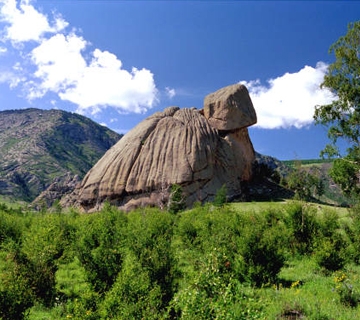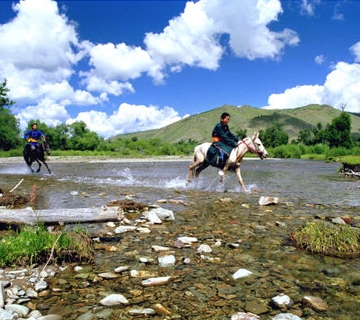You are here: Home » Mongolia » Introduction to Mongolia
|
Photos
 Mongolian wonderful narute  Mongolian lengendary horse  Mongolian boy
|
Description
The southernmost third of Mongolia is occupied by an immense desert region, whose name universally conjures up images of the remote, the exotic, the formidable: the great Gobi. The scale of the Gobian landscape is indeed breathtaking, but first-time visitors may be surprised at the great variety and beauty in the desert landscapes. While its towering sand dunes will not disappoint, the craggy, juniper clad peaks of the Gobian Altai, the “forests†of hardy saxaul, the surprisingly colorful desert flora, and the bird-filled desert lakes are no less enchanting. And of course no visit to the Gobi can omit an exploration of the red sandstone spires of the Flaming Cliffs, where Roy Chapman Andrews started the still-thriving Mongolian dinosaur rush by bringing to light the first Oviraptor eggs. The rich variety of undisturbed habitats described above makes Mongolia one of the best temperate zone wildlife-viewing countries in the world. Elk are common in the northern forests and sometimes wander within the city limits of Ulaanbaatar. Mountain regions throughout the country harbor healthy populations of Argali, the largest of the world’s bighorn sheep, and Ibex, the agile mountain goat. The eastern steppe supports immense herds of Mongolian Gazelles – the largest herds of wild hoofed animals in the world outside of Africa, and its close relative, the Goitered Gazelle is locally common in the Gobi. The world’s last true wild horse, the Takhi, or Przewalski’s Horse, now runs free on a spectacular steppe reserve just a couple of hours from the capital, and though they are seldom seen, some of the rarest mammals in the world, including Saiga Antelope, Asian Wild Ass, Wild Bactrian Camel and Gobi Bear maintain fragile populations in the Mongolian wilderness. The Mongolian Altai remains a stronghold for the queen of cats, the elusive Snow Leopard. Birding in Mongolia can be spectacular, with both large concentrations of migrants in spring and fall and an enticing selection of near endemics and Eurasian specialties. The conifer forests hold the likes of Black-billed Capercaillie, Red-throated Thrush, Daurian Redstart, Long-tailed Rosefinch and a challenging assortment of leaf warblers. In the steppes, Ruddy Shelducks, Demoiselle Cranes, and Mongolian and other Larks are almost always in view while you scan for the more elusive Great and McQueen’s Bustards. Raptors such as Steppe and Golden Eagles, Upland Buzzard and Saker and Amur Falcon are common, and White-tailed and Pallas’s Fish Eagles are reliable in certain localities. The mountains offer the likes of Altai Snowcock, Lammergeier, Wallcreeper, Koslov’s and other Accentors, Beautiful and other Rosefinches, and Pere David’s Snow Finch. Certain lakes are habitat for Dalmatian Pelican, Swan Goose, White-headed Duck, Relict and Pallas’s Gulls, many species of Asian waders and large concentrations of Palearctic waterbirds in general. In the Gobi, birders will find specialties such as Mongolian (Henderson’s) Ground Jay, Oriental Plover, Isabelline Shrike, Mongolian Finch and Saxaul Sparrow. (Bird lists are available on request.) While there is no denying the thrill of seeing spectacular wildlife or the pleasure of a great day’s birding, Mongolia brings its own unique quality to spending time in nature in the 21st century. Strip malls are absent, power lines are scarce, human habitation, if present at all, is likely to consist of a few nomad gers dwarfed by the landscape – a reminder of what the Great Plains of North America must have looked like 300 years ago. All sense of urgency seems to dissipate out over the meadows of wildflowers or up into the famous Mongolian blue sky. The nomads themselves also have a calming quality: welcoming, big-hearted, strong but gentle, comfortable in their time-tested relationship with their harsh but glorious land. Visitors to the Mongolian countryside always go away with travelers’ tales, but they return (as many do) looking to recapture a sense of peace that they have found nowhere else. |
General info
|





